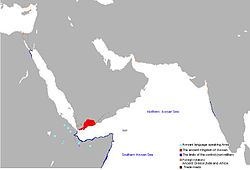Awsan
This article includes a list of references, related reading, or external links, but its sources remain unclear because it lacks inline citations. (November 2016) |
Kingdom of Awsan | |||||||
|---|---|---|---|---|---|---|---|
| 8th century BC–7th century BC | |||||||
 | |||||||
| Capital | Ḥajar Yaḥirr | ||||||
| Common languages | Old South Arabian | ||||||
| Religion | Arabian paganism | ||||||
| History | |||||||
• Established | 8th century BC | ||||||
• Disestablished | 7th century BC | ||||||
| |||||||
| Today part of | Yemen | ||||||
| Part of a series on the |
| History of Yemen |
|---|
|
|
The Kingdom of Awsan, commonly known simply as Awsan (Qatabanian: 𐩱𐩥𐩯𐩬, romanized: ʾwsn; Arabic: أوسان, romanized: ʾAwsān), was a kingdom in Ancient South Arabia centered around Wadi Markha, Yemen that existed in two periods, early and late. The earliest known mention of Awsan was in the 8th century BC, and its destruction was in the start of the following century.[1] The later kingdom of Awsan emerged around or after the 2nd century BC, its independence waning and waxing against Qatabanic control of the area.[2]
History
[edit]First impressions in the mid-1990s, based on ceramics found by M. Saad Ayoub at the unexcavated site, date a resurgence of the city to the end of the 2nd century BCE lasting until the beginning of the 1st century CE (which corresponds quite well to the epigraphic data attesting the only deified South Arabian king that was just the king of Awsān precisely around this time). About 160,000 m2 were encircled by walls, and the foundations of dwellings built of fired brick have been noted. Culture depended on annual flood irrigation in spring and summer, when flash floods down the wadis temporarily flooded the fields, leaving light silt that has since been wind-eroded, revealing the ancient patterns of fields and ditches. Radiocarbon dating of irrigation sediments in the environs suggest that essential irrigation was abandoned in the first half of the 1st century CE, and the population dispersed. This time the site was never rebuilt.
Hagar Yahirr was the center of an exceptionally large city for South Arabia, influenced by Hellenistic culture, with temples and a palace structure surrounded by mudbrick dwellings, with a probable site for a souq or market and a caravanserai serving camel caravans. One of its kings at this period was the only Yemeni ruler to be accorded divine honours; his surviving portrait statuette is dressed in Greek fashion, contrasting with those of his predecessors who are dressed in Arabian style, with kilt and shawl. There are Awsān inscriptions, in the Qatabānian language.
The siting of Ḥajar Yaḥirr is consistent with other capitals of petty kingdoms, at the mouths of large wādīs: Ma`īn in the Wādī al-Jawf, Ma'rib in Wādī Dana, Timna in Wādī Bayhān, and Shabwah in Wādī 'Irmah.
References
[edit]- ^ الباسط), Mahmoud abd El-Basset (محمود عبد. "Written sources for the study of the kingdom of Awsan's history (in Arabic) المصادر الكتابية لدراسة تاريخ مملكة أوسان".
{{cite journal}}: Cite journal requires|journal=(help) - ^ Avanzini, Alessandra (2016). By Land and By Sea: A History of South Arabia before Islam Recounted from Inscriptions. «l’erMA» di BretSchneIDer. p. 201. ISBN 978-88-913-1118-4.
{{cite book}}: CS1 maint: date and year (link)
- Caravan Kingdoms: Yemen and the Ancient Incense Trade Freer Gallery, Washington, 2005. Exhibition of archeological objects from Yemen, setting Awsan in context. Catalogue.
- Robert Hoyland, Arabia and the Arabs: From the Bronze Age to the Coming of Islam (series Ancient Peoples)
- Freya Stark and Jane Geniesse The Southern Gates of Arabia: A Journey in the Hadhramaut
External links
[edit]- Télédetection archéologique dans la Wadi Markha (in French)




